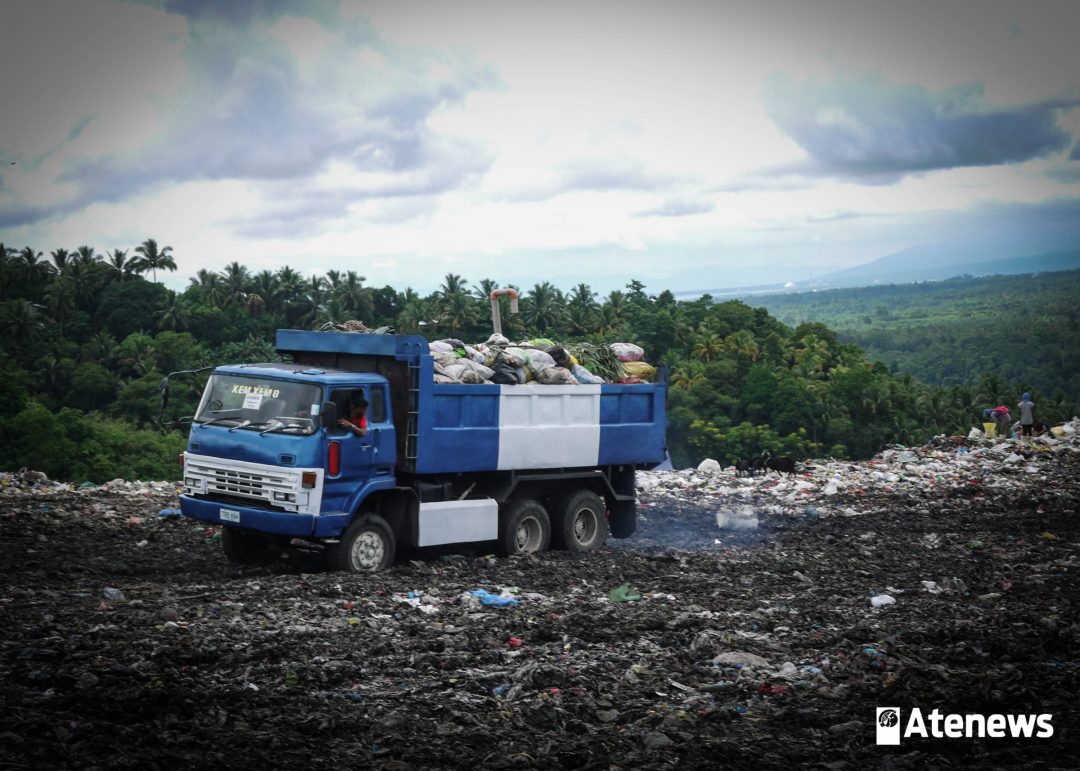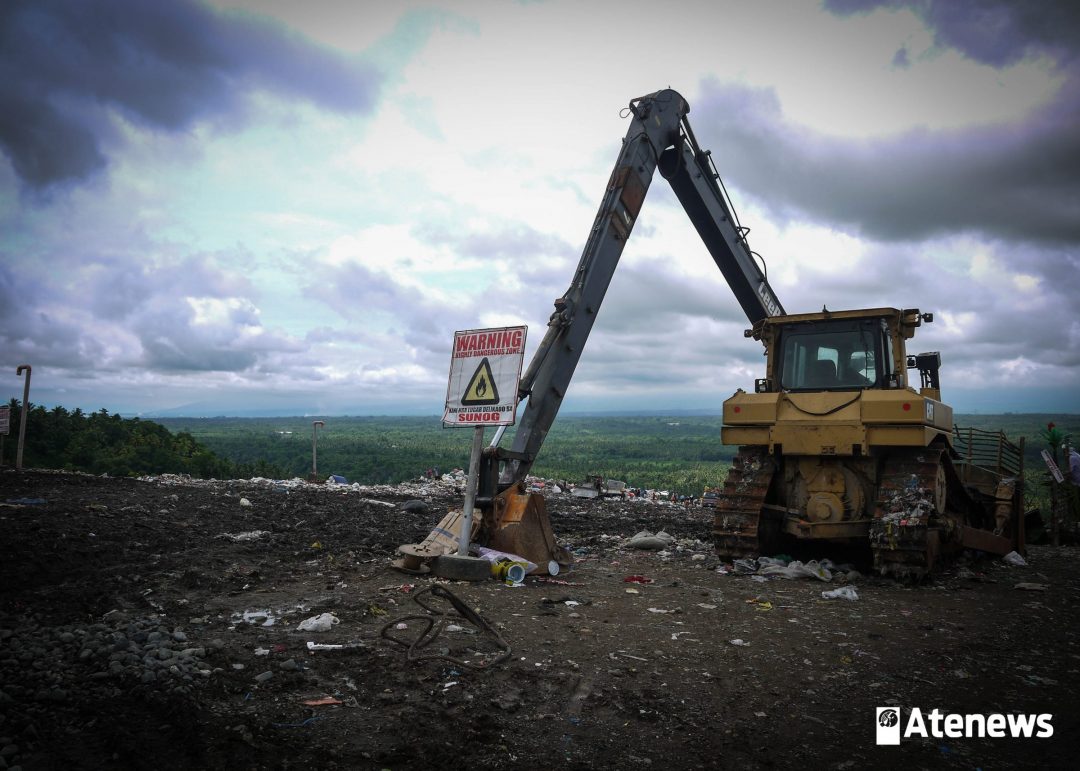Every night for 17 years, Rosello Ingai donned his worn rubber boots. Covered in a long sleeved shirt and trousers with a head lamp fixed on his brow, an empty sack slung across his back, and a sickle-like tool in his right hand, he could well be a soldier going into battle or a pitman about to enter a mine. Except that, for Rosello, the battlefield was filled with a mob of waste pickers instead of soldiers and the colliery, instead of coal, was made up of trash.
Rosello, 44, is one of the hundreds relying on Davao City’s New Carmen landfill for a living. Although now employed as a truck driver, he still sidelines as a scavenger on weekends to supplement his income. Every day as garbage trucks dump tons of wastes from 9 in the evening until 3 in the morning, scavengers like Rosello collect glass, plastics, metals, sacks, and cardboard, among other things that still have value. A “fresh” pile is usually seen as premium, so scavengers often run towards trucks in the middle of dumping. Sometimes—and it has happened before—trucks lose their breaks, accidentally running over some excited waste pickers and killing them.
By week’s end, the accumulated trash items would be weighed and sold to nearby junk dealers. For his part, Rosello makes an income of Php 2000 to 2300 per week. Others are also lucky to find more valuable items like money, mobile phones, and even gold.
“So mao na siya kung ma baligya na namo, mahalinan mi og sobra libo, semana ba, mao pud na’y ipalit namo og bugas… pasalamat ko aning basura kay mao pud ni nag-improve sa akong kinabuhi og sa akong pamilya, dili pud ko makatalikod ani. Mao bitaw’ng hangtod karon nga naa gihapon ko diri…” Rosello told me October last year when I asked about what the landfill means for him.
I had been on “informal” anthropological fieldwork for an assigned case study in my Environmental Anthropology course, and although we were discouraged from going to the field, I insisted on going under a few compromises and with the inconvenience of wearing a protective mask and face shield.
Now beyond its maximum capacity, the New Carmen landfill also owes it to the informal waste sector for somehow, albeit marginally, reducing the volume of waste. But the same group of people is at risk of losing their primary source of living with a new project from the city government which seeks to address the waste crisis.

Davao City’s waste crisis
According to data from the Davao City Government, the spike in population and business establishments in the city for the past five years has led to an increase in waste. From 2017 to 2019, for example, solid waste disposal at the sanitary landfill rose from an average of 575 tons per day to 614 tons per day.
Failure in the barangay level to establish and implement a Materials Recovery Facility (MRF) for recyclable wastes and a composting facility for biodegradable wastes has also compounded the problem. As a result, the landfill has reached its maximum capacity as early as 2016. Engineers from the City Environment and Natural Resources Office (CENRO) confirmed that they are left with no choice but to doze the wastes farther into the landfill to prevent it from spilling over to the access road. Currently, leachate spill from the dumpsite is contaminating the Matina Pangi river.
Although the city government says that it is now in the process of acquiring a new lot to construct another landfill, Engr. Lakandiwa Orcullo from CENRO’s Waste Management Division said that citing a new landfill is difficult, especially for highly urbanized areas like Davao.
“Naay requirement ang National Solid Waste Commission nga unsay requirements sa pag site sa sanitary landfill… para sa amoa lisod mangita og land kay kung tan-awon nimo, mubagsak siya sa isa ka exclusion criteria, ngita gyud ka’g lain site so mao nang hinungdan gyud nga murag ni decide ang city nga mu WTE (Waste-to-Energy) kay lisod mangita og sanitary landfill unya nagkadaghan ang volume sa basura sa syudad,” he said in an interview.

“Waste-to-Energy or Waste of Energy?”
So, what is WTE? Is it the way to go?
According to the United States’ Environmental Protection Agency, WTE is “the conversion of non-recyclable waste materials into usable heat, electricity, or fuel through a variety of processes.” In the context of Davao City, this will be done through “incineration” and “gasification”, or simply, through burning.
The facility is expected to operate at Barangay Biao Escuela, a few kilometers away from New Carmen. Once operational, the LGU will supply solid waste into the facility and haul out the ash, which is estimated at 30 to 60 tons, all the way to a sanitary landfill. The LGU boasts that it will mitigate wastes by 80%-90% while simultaneously generating energy estimated at 11 megawatts.
So far, the WTE project implementation has started, but the LGU has yet to select a company which will build and operate the facility, said Assistant City Administrator Atty. Tristan Dwight Domingo in an interview October last year. Meanwhile, funding for the incinerator will be provided through a grant from the Government of Japan.
“We will benefit from this project primarily through having one of, if not the most, efficient and sustainable ways to manage solid waste. It will be a first of its kind in the entire country. We will be doing away with the current practice of building numerous and huge landfills in the city,” he said.
However, environmental groups have expressed strong opposition to WTE for a variety of reasons. At its core, they believe that WTE technology does not solve the root cause of the waste management problem and only undermines real Zero Waste solutions. Groups such as No Burn Pilipinas, Interfacing Development Interventions for Sustainability (IDIS), and AdDU’s Ecoteneo argue that WTE only encourages LGUs to consume more materials and produce more waste in order to meet the waste volume quotas determined by profiteering WTE contractors.
They also cite how the burning of non-biodegradable waste to produce energy or incineration, has been scientifically shown to pose huge health and environmental risks, such as cancer-causing dioxins and furans, as well as direct carbon dioxide emissions.
Although the city has said it will observe proper monitoring mechanisms, the said groups point to the LGU’s non-commitment to monthly dioxin monitoring which is the standard in first world countries using WTE technology.
In a statement from the Sustainable Davao Movement, incinerators were dubbed as “a massive waste of energy.” Without first putting in place proper waste segregation, Davao’s WTE might generate only small amounts of energy while destroying large amounts of reusable materials.
But what about the waste pickers? Where do they locate themselves amid all these conflicting positions?
I was surprised to discover through my interviews in the community that information regarding the WTE project has not really trickled down to the grassroots, including the informal waste workers. Much of the interactions that they had with the local government and NGOs were in the form of vaccinations, feeding programs, and the like. News regarding developments in the landfill were known by residents like Rosello only in the form of chismis or gossip which has been passed down by public safety workers. Even the Purok Leader did not exactly refer to the current WTE project when I asked about waste burning.
This disconnect between the LGU and environmental groups with the waste pickers, for me, was very telling of the disparate truths that the different sectors had about garbage (see Drackner 2005). While for the LGU, waste was seen more as an aesthetic inconvenience, NGOs seemed to perceive waste as a risk to health and the environment. Meanwhile, I concluded that waste was an asset for the informal waste sector. An income-generating commodity—a source of life.
It was ironic because one of the most affected sectors was not given information nor allowed participation in the WTE dispute. Jobs like waste picking and recycling are at risk of being destroyed since the materials burned in incinerators are often the same materials that sustain their activities such as paper and plastics.
Rosello and his companions in the informal waste sector fear for their jobs. With the WTE facility, what was then life-giving mountains of waste would be reduced to nothing but barren deserts of ash. While the LGU says waste pickers can benefit even more with WTE since it requires strict segregation before processing, they have yet to come up with a concrete and specific plan of action in terms of the actual jobs that waste pickers can take as an alternative.
“Actually mao gyud na’y isa ka tan-awunon sa syudad no kay kung muabot sa panahon, wala na gyud silay ma ukay pa diha… by that time naa man pud mi gina propose pud na mag establish og central MRF unya kanang mga tawhana na lang ang mu man–ambot dili pud ko kasulti na mao nay plano sa syudad pero isa na sa posibilidad,” Engr. Orcullo admitted.
At the end of the day, perhaps the question to ask is not only whether WTE is the better solution to our waste problem. We also have to pay attention to questions of equitability along with sustainability. In our preoccupation with debates on how best to improve life in Davao, whose voices are obscured and caught in the middle? Consequently, how best can we address the waste crisis without rendering these people’s struggles invisible?
Out of curiosity, I asked Rosello why he still continues to pick wastes at the landfill despite his job as a truck driver.
“Naanad na man pud ko. Pero mag basura basura gihapon ko diri panagsa kay mingawon man pud ko.”
References
Drackner, Mikael. “What Is Waste? To Whom? – An Anthropological Perspective on Garbage.” Waste Management & Research 23, no. 3 (2005): 175–81. https://doi.org/10.1177/0734242×05054325.
“Energy Recovery from Waste | Municipal Solid Waste.” EPA. Environmental Protection Agency, September 27, 2013. https://archive.epa.gov/epawaste/nonhaz/municipal/web/html/index-11.html.